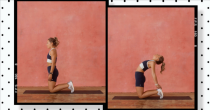Welcome to our weekly Move of the Week series. Every Monday, we’ll be sharing with you one of our favourite exercises – how to do them, what muscles they work and why they should be a regular part of your workout regime. This week: camel stretch.
In yoga, backbends can be intimidating. We’re not used to trusting ourselves to fall backwards – especially as our default position tends to be benched and rounded. But that desk-working posture is exactly why we need to safely include backbends in our practice.
Camel pose is a great introduction to spinal extension poses, giving you all the benefits of backbends but with some extra support and stability.
You may also like
Move of the week: puppy dog pose eases a stiff upper back and tight chest
What is camel stretch?
A camel stretch is a gentle backend that is performed on your knees, stabilising your body with your heels.
This exercise is great because:
It stretches the front of your body: areas like the hip flexors and chest can get tight from long periods of sitting, so it’s important to stretch them out.
It can improve stability: you need to remain strong and well balanced while performing the move, particularly through the back of the body.
It can help you de-stress: backbends create space through the ribs and chest – called the ‘heart centre’ in yoga – which can help you connect and slow your breathing.
What muscles do backbends work?
The backbend can work the whole body, including:
- Pecs
- Anterior delts
- Hip flexors
- Quads
- Hamstrings
- Glutes
- Back
- Posterior delts
- Traps
- Neck
You may also like
Reverse lunge your way to injury-proof key running muscles
How to do a camel stretch
- Begin in a tall kneeling position, with your thighs lifted away from your calves and feet.
- Tuck your toes under your, squeeze your glutes and tuck your tailbone to limit arching through the lower back.
- Reach your hands behind you to grab the back of your heels.
- Let your chest open and your neck slowly roll back as you push your pubic bone forwards.
Images: Stylist
Source: Read Full Article
